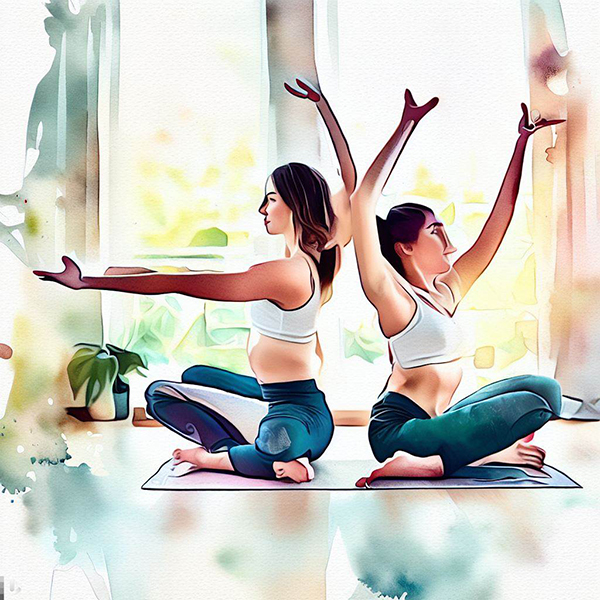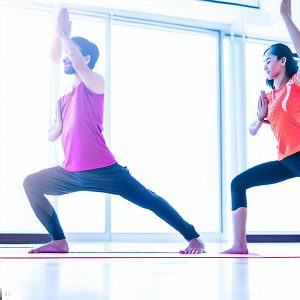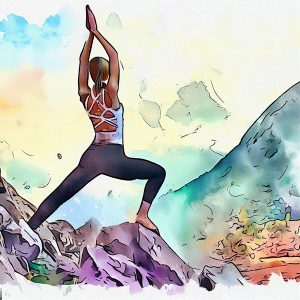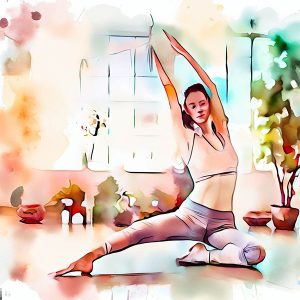Yoga is much more than physical postures on a mat; it’s a comprehensive system that guides practitioners toward mental, physical, and spiritual equilibrium.
The Essence of Yoga: Exploring the Meaning and Significance of the 8 Limbs of Yoga
At the heart of this ancient practice lies the concept of the Eight Limbs of Yoga, a profound framework that offers a holistic path to well-being. In this article, we delve into each limb’s significance, exploring how they work together to cultivate balance and lead us toward self-realization.
1. Yama: Ethical Principles: The Yamas are universal ethical principles that guide our interactions with the external world. They include Ahimsa (non-violence), Satya (truthfulness), Asteya (non-stealing), Brahmacharya (moderation), and Aparigraha (non-possessiveness). Practicing the Yamas fosters compassion, honesty, and integrity, both in our relationships and within ourselves.
2. Niyama: Personal Observances: The Niyamas focus on self-discipline and inner observances. They comprise Saucha (cleanliness), Santosha (contentment), Tapas (self-discipline), Svadhyaya (self-study), and Ishvara Pranidhana (surrender to a higher power). Niyama practices foster self-awareness, inner peace, and spiritual growth.
3. Asana: Physical Postures: The practice of physical postures, or asanas, is what most people associate with yoga. Asanas cultivate physical strength, flexibility, and balance. Beyond the physical benefits, they prepare the body for meditation and breath control.
4. Pranayama: Breath Control: Pranayama involves conscious control of the breath, promoting proper oxygenation and energy flow in the body. Breathing techniques expand lung capacity, calm the mind, and regulate the vital life force, or prana.
5. Pratyahara: Withdrawal of the Senses: Pratyahara is the withdrawal of the senses from external stimuli. By turning inward and disconnecting from sensory distractions, practitioners cultivate focus, self-awareness, and mental clarity.
6. Dharana: Concentration: Dharana is the practice of unwavering concentration. It involves focusing the mind on a single point, developing mental discipline, and preparing the mind for meditation.
7. Dhyana: Meditation: Dhyana is the state of meditation—profound contemplation and focused awareness. It deepens concentration, reduces mental fluctuations, and paves the way for self-realization.
8. Samadhi: Union with the Divine: Samadhi is the ultimate goal of yoga—an experience of profound oneness with the universe. It’s a state of pure consciousness, where the self merges with the divine, transcending ego and achieving a state of ultimate liberation.
The Path to Wholeness The Eight Limbs of Yoga offer a multifaceted approach to well-being, encompassing ethical principles, physical practices, and profound spiritual growth. By embracing each limb, practitioners can cultivate balance, mindfulness, and self-realization. While each limb is significant on its own, their synergy fosters a holistic transformation that extends beyond the mat. Whether you’re a seasoned yogi or new to the practice, the Eight Limbs of Yoga provide a comprehensive roadmap toward inner peace, alignment, and the realization of our true potential.
Benefits of Practicing the Eight Limbs of Yoga: A Holistic Approach to Well-Being
- Ethical Clarity: Embracing the Yamas (ethical principles) cultivates moral integrity, leading to healthier relationships, improved communication, and a sense of harmony in interactions.
- Inner Peace: The Niyamas (personal observances) encourage self-discipline, contentment, and self-study, fostering inner tranquility and a positive self-image.
- Physical Vitality: Asana practice enhances physical strength, flexibility, and posture, promoting a healthier body and a more energized lifestyle.
- Enhanced Breath Awareness: Pranayama (breath control) techniques improve respiratory health, oxygenate the body, and enhance mental clarity through focused breath work.
- Stress Reduction: Pratyahara (withdrawal of the senses) fosters mindfulness and reduces stress by redirecting attention from external distractions to inner awareness.
- Sharper Concentration: Dharana (concentration) sharpens focus, enhances cognitive abilities, and supports efficient problem-solving and decision-making.
- Mindfulness Mastery: Dhyana (meditation) practice fosters mental clarity, emotional balance, and mindfulness, allowing you to live more fully in the present moment.
- Transcendent Liberation: Samadhi (union with the divine) offers liberation from ego-driven thoughts, leading to spiritual enlightenment, inner peace, and a profound sense of oneness.
- Holistic Growth: Embracing all eight limbs synergistically promotes holistic well-being, encompassing physical, mental, emotional, and spiritual dimensions.
- Stress Management: The Eight Limbs provide tools for stress relief, self-awareness, and emotional regulation, aiding in the management of daily pressures.
- Enhanced Self-Understanding: The introspective practices of the Eight Limbs foster self-awareness, helping you better understand your thoughts, emotions, and behaviors.
- Spiritual Evolution: Practicing the Eight Limbs deepens your connection with your spiritual self, leading to a greater sense of purpose, fulfillment, and inner transformation.
- Alignment with Life Values: The ethical guidelines of the Yamas help align your actions with your values, promoting a sense of integrity and authenticity in your choices.
- Calm Mindset: The Eight Limbs encourage a calm and focused mindset, reducing anxiety, promoting mental clarity, and allowing for better decision-making.
- Increased Resilience: Regular practice of the Eight Limbs helps you build emotional resilience and cope more effectively with life’s challenges.
By embracing the Eight Limbs of Yoga, you embark on a journey that enriches every aspect of your life—physical, mental, emotional, and spiritual. The benefits extend beyond the mat, shaping your interactions, mindset, and overall well-being.
Testimonials about Practicing Yoga
“Discovering the Eight Limbs of Yoga has been a transformative journey. It’s not just about physical postures; it’s a comprehensive roadmap for living a balanced life. Through the Yamas and Niyamas, I’ve found a deeper connection with myself and those around me. The asana practice strengthens my body, while pranayama and meditation calm my mind. This holistic approach has brought a sense of purpose and fulfillment to my everyday existence.”
- Estelle Huff
“The Eight Limbs of Yoga have opened up new dimensions of self-awareness and growth for me. Practicing these limbs has taught me to approach life with mindfulness, compassion, and integrity. As I delve into each limb, I find myself more grounded, focused, and connected. This journey has not only improved my physical and mental well-being but has also kindled a spiritual awakening that fuels my daily interactions and decisions.”
- Saira Brown
Embrace Holistic Well-Being Through the Eight Limbs of Yoga
Are you ready to embark on a transformative journey that enriches your mind, body, and spirit? Dive into the profound teachings of the Eight Limbs of Yoga and experience a holistic approach to enhancing your quality of life:
1. Embrace Ethical Living: Incorporate the Yamas into your daily interactions, cultivating compassion, truthfulness, and integrity in your relationships.
2. Foster Self-Growth: Embrace the Niyamas, practicing self-discipline, contentment, and self-study to nurture a positive self-image and inner peace.
3. Enhance Physical Vitality: Engage in asana practice to improve physical strength, flexibility, and posture, promoting a healthier, more active lifestyle.
4. Master Your Breath: Explore pranayama techniques to enhance your respiratory health, sharpen mental focus, and promote overall well-being.
5. Find Inner Calm: Practice Pratyahara to withdraw from external distractions and cultivate mindfulness, reducing stress and fostering tranquility.
6. Sharpen Your Focus: Develop the art of concentration through Dharana, enhancing cognitive abilities and improving decision-making.
7. Cultivate Mindfulness: Embrace meditation (Dhyana) to quiet your mind, enhance emotional balance, and savor each moment with greater awareness.
8. Experience Oneness: Journey toward Samadhi, where you can experience profound liberation from ego-driven thoughts and connect with the divine essence within.
Elevate Your Life Through the Eight Limbs Embracing the Eight Limbs of Yoga is an invitation to explore a more balanced, harmonious, and fulfilling life. By incorporating these principles into your daily routine, you’ll discover a profound sense of well-being that extends beyond the mat. Take the first step on this transformative path and embark on a journey that nurtures your mind, invigorates your body, and enriches your soul. Let the wisdom of the Eight Limbs guide you toward a life of mindfulness, purpose, and self-realization.
Possible Concerns and Limitations:
- Misinterpretation: Misunderstanding the Eight Limbs of Yoga as rigid rules rather than guiding principles might lead to a sense of restriction or failure to embrace their essence.
- Overemphasis on One Limb: Focusing solely on physical postures (asana) and neglecting other limbs may lead to an imbalanced practice, missing out on the holistic benefits.
- Cultural Sensitivity: The Eight Limbs originate from ancient Indian philosophy. Practitioners should approach the practice with cultural respect and sensitivity.
Physical Restrictions:
- Injury or Health Conditions: Individuals with injuries, chronic conditions, or physical limitations should adapt their practice to suit their body’s needs and consult healthcare professionals when necessary.
- Physical Limitations: Some asanas may not be suitable for individuals with specific physical limitations, and modifications might be necessary.
Importance of Consulting a Health Professional:
- Pre-existing Medical Conditions: If you have medical conditions like cardiovascular issues, respiratory problems, or joint concerns, consult a healthcare provider before beginning any yoga practice, including the Eight Limbs.
- Pregnancy: Pregnant individuals should adapt their practice under professional guidance to ensure the safety of both the practitioner and the baby.
- Mental Health: Individuals with mental health concerns should approach meditation and concentration practices with care, and consultation with mental health professionals is advisable.
Adapting for Your Well-Being:
- Customization: Adapt the Eight Limbs to suit your individual physical, mental, and emotional needs. Modify practices as necessary while staying true to the principles.
- Progress Gradually: Progress through the Eight Limbs gradually, focusing on mastery of each before moving on to the next. Rushing may lead to overwhelm.
- Professional Guidance: If you’re new to yoga or have specific health considerations, seek guidance from experienced yoga instructors or healthcare professionals.
Mindful and Informed Practice While the Eight Limbs of Yoga offer a transformative path to well-being, it’s crucial to approach the practice with mindfulness and self-awareness. Consulting healthcare professionals, respecting your body’s limitations, and customizing the practice to suit your needs are essential steps to ensure a safe and fulfilling journey. By cultivating a mindful, well-informed practice, you can embrace the wisdom of the Eight Limbs while prioritizing your physical and mental health (Wikipedia).
Questions and Answers about: What are the 8 Limbs of Yoga?
What are the Eight Limbs of Yoga? The Eight Limbs of Yoga, as outlined in Patanjali’s Yoga Sutras, are a comprehensive framework for holistic well-being. They include ethical principles, physical postures, breath control, meditation, and ultimately, union with the divine.
How do the Yamas and Niyamas differ from other limbs? The Yamas are ethical principles governing how we relate to others, while the Niyamas focus on personal observances that nurture self-discipline, contentment, and self-study.
Why is asana practice just one limb of yoga? Asana, or physical postures, is a vital component of yoga, promoting physical health and preparing the body for meditation. However, the Eight Limbs emphasize a holistic approach beyond just the physical aspect.
How do the Eight Limbs foster self-awareness? Through practices like breath control (pranayama) and meditation (dhyana), the Eight Limbs encourage self-awareness, helping individuals observe their thoughts, emotions, and inner state.
Is Samadhi achievable for everyone? Samadhi, the final limb, represents a profound state of self-realization and union with the divine. While it’s the ultimate goal, the journey toward it varies for each individual and may require years of dedicated practice.
Can the Eight Limbs of Yoga be practiced independently? While each limb holds value on its own, the Eight Limbs are interconnected. Practicing them collectively creates a synergistic effect that fosters balance, well-being, and spiritual growth.









